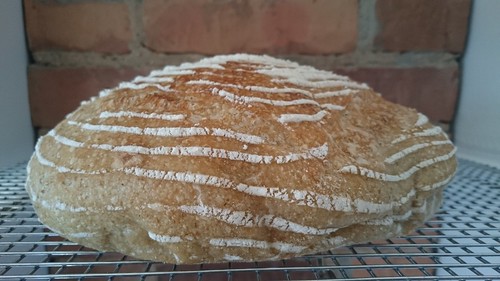Classic Sourdough Bread (Pain au Levain)
A recent issue of Cook’s Illustrated magazine promoted a no-knead sourdough bread, and because I’ve got a nice, tangy levain right now, I wanted to try it. However, in the fine print, they noted that there’s an even better variation as an online extra. Their take on pain au levain took a lot more time, but boy, was it worth it.
This recipe differs from their published no-knead recipe by using a small portion of whole wheat flour, as well as additional folds to further develop the dough. However, it takes much more time as you can see from this schedule:
- (20 min) Stir dough, rest. - (30 min) Add salt, rest. - (30 min) Fold dough, rest (1) - (30 min) Fold dough, rest (2) - (30 min) Fold dough, rest (3) - (30 min) Fold dough, rest (4) - (60 min) Shape, rest. - (12-24 hr) Refrigerate. - (2-3 hr) Proof - (60 min) Bake
I was able to fit this into my weekday schedule, by doing the first set of steps right after dinner, then doing the final proof and bake on the following evening.
Ensure that you thoroughly flour your bowl or banneton, as this dough is quite wet, and it ferments in the fridge for an extended period of time. On one occasion when I made this bread, I used a bleached, all-purpose flour to dust the banneton, and my dough stuck quite stubbornly. I ended up pouring out the dough, pulling and scraping it onto the parchment, ruining the appearance of the loaf (it turned out fine after baking).
The most impressive thing about this bread, for me, were the wonderfully large, irregular holes I was able to achieve. As with other breads I’ve made in a covered Dutch oven, the crust browned and blistered thoroughly, and yielded a satisfying chew. I would prefer a less flat loaf, but that depends on the size of your proofing container, and how wet and well-kneaded your dough is.
A few other notes on the recipe:
-
My banneton diameter was 8”, which I thought might be too small for this quantity of dough, but it fit perfectly, without any spillover. Using a too-large bowl runs the risk of the dough deflating when you invert it onto your parchment.
-
The large quantity (226 g) of starter in the ingredients means this recipe cuts down on waste when you are refreshing your starter (which I do weekly now).
-
Whether you sift your whole wheat flour to remove the bran didn’t seem to matter to me. I’ve made it with and without sifting, I liked the texture of both loaves.



Leave a comment